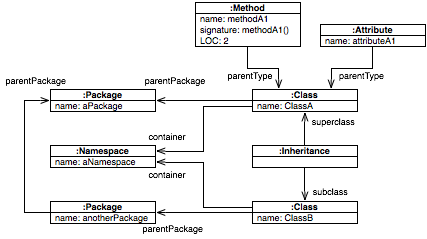File format
Moose is compatible with two file formats: JSON and MSE. In the following, we describe how each file must be written when exporting a model. When exporting a meta-model, additional types are automatically added (known my the meta-meta model). If you need to export/import a meta-model check the JSON or MSE format and the Existing types.
JSON
JSON is a famous file with parsers and generators supported by many languages. Here, we will not detail the JSON format but how it must be used to be loaded as a Moose model.
[
{
"FM3": "EntityTypeName",
"id": 1,
"propertyOne": "string property value"
},
{
"FM3": "AnotherAnotherEntityType",
"id": 2,
"entityProperty": {
"FM3": "EntityTypeName",
"id": 3,
"propertyInteger": 42
}
},
{
"FM3": "AnotherAnotherEntityType",
"id": 4,
"propertyThatReferesAnotherEntity": { "ref": 1 }
}
]
A model is represented as a collection of entities ([ <entities> ]).
Each entity has a type (the class that will be created).
In the file, the name of the property is the value of the property FM3.
This Json property must be the first property of an entity.
Whereas this does not follow JSON guidelines, it offers better performance.
FM3 means Fame3. It is in reference to Fame, the meta-meta-model used in Moose.
{
"FM3": "EntityTypeName"
}
An entity has also an optional unique id used when an entity refers to another. Note that the id must arrive right after the FM3 property. Whereas it does not follow JSON guidelines, it offers better performance.
{
"FM3": "EntityTypeName",
"id": 42
}
Then, the entity has several properties. Properties can be:
- String (
"name": "a string property") - Integer (
"line of code": 42) - Float (
"complexity": 42.2) - Another entity (
"parentClass": { "FM3": "Famix-Java-Entities.Class", "id": 3 }) - Reference to another entity (
"parentClass": { "ref": 3})
MSE
MSE is the default file format supported by Moose. It is a generic file format and can describe any model. It is similar to XML, the main difference being that instead of using verbose tags, it makes use of parentheses to denote the beginning and ending of an element.
The following snippet provides an example of a small model:
((FamixJava.Namespace (id: 1)
(name 'aNamespace'))
(FamixJava.Package (id: 201)
(name 'aPackage'))
(FamixJava.Package (id: 202)
(name 'anotherPackage')
(parentPackage (ref: 201)))
(FamixJava.Class (id: 2)
(name 'ClassA')
(container (ref: 1))
(parentPackage (ref: 201)))
(FamixJava.Method
(name 'methodA1')
(signature 'methodA1()')
(parentType (ref: 2))
(LOC 2))
(FamixJava.Attribute
(name 'attributeA1')
(parentType (ref: 2)))
(FamixJava.Class (id: 3)
(name 'ClassB')
(container (ref: 1))
(parentPackage (ref: 202)))
(FamixJava.Inheritance
(subclass (ref: 3))
(superclass (ref: 2))))
The file defines 8 entities: 1 Namespace, 2 Packages, 2 Classes, 1 Method, 1 Attribute, and 1 Inheritance. For each of these entities, it provides a unique identifier (e.g., (id: 1)) and it defines properties. In general, properties can be either primitive, like (name ‘aNamespace’), or they can point to another entity, like in the case of (container (ref: 1)) which denotes that the container property of ClassA points to the instance of Namespace named aNamespace.
The overall object graph can be seen graphically below.

Existing types
Fame (the meta-meta model used by Moose) defines the following type for properties:
- Character
- Number
- Fraction
- String
- Symbol
- Boolean
- Object
Using the Object, you will not be able to export the property in .mse and .json (see: import and export model).
So, when creating the mse or JSON of a meta-model these type can appear in the ref.
For instance, for MSE, the last type reference the already Fame known String type. The same approach is used in JSON format
(
(FM3.Package (id: 1)
(name 'Tagging')
(classes
(FM3.Class (id: 2)
(name 'Category')
(abstract false)
(package (ref: 1))
(superclass (ref: 3))
(properties
(FM3.Property (id: 4)
(name 'name')
(class (ref: 2))
(container false)
(derived false)
(multivalued false)
(type (ref: String))
)
)
)
)
)
)